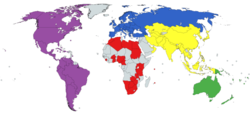History
Indoor hockey developed in Germany during the 1950s, quickly spreading to other European nations. Belgium was one of the countries to adopt the field hockey variant, and in 1966 René Frank, a native of Belgium, who was later to become President of the FIH, persuaded the German Hockey Associations to give responsibility over the rules of Indoor Hockey to the FIH. This led to the FIH recognising indoor hockey in its constitution in 1968. [3]
Whereas in many countries field hockey is played all year long, in Germany, The Netherlands and Austria the hockey season is divided evenly into a field hockey half in summer and an indoor hockey season in winter.
The first FIH sanctioned tournament matches of Indoor Hockey were played in 1972.
World Cup
The International Hockey Federation organizes the Indoor Hockey World Cup. The first Indoor World Cup was held in Leipzig, Germany, in 2003, where the home nation won both the men's and women's gold medals. Eurosport television ratings for the recent Indoor Hockey World Cup, held in Leipzig, Germany, have shown the event to garner large audiences. A total of 20 million viewers watched 13 hours broadcast on Eurosport, with ten matches aired live. Peak viewing audience reached 889,000 viewers during the opening Poland vs. USA match, with the average live viewing figure for the whole tournament at 601,000. Germany and Poland, Eurosport's two strongest markets, showed particular interest, with more than 4 million different viewers tuning in from Germany, and more than 1.5 million watching from Poland. The average audience, calculated across several of Eurosport's key territories, showed a strong bias towards young males according to Eurosport's research. Arnaud Simon, Eurosport's Program Director commented: 'The first Indoor World Cup was a very exciting event, well suited for television and with good production standards. These characteristics were rewarded with very strong ratings, particularly considering that many of the matches were aired at off-peak viewing times.'
Els van Breda Vriesman, the president of the International Hockey Federation, added: 'The figures speak for themselves, proving not only that hockey has mass appeal on television, but also that the target audience presents a very attractive commercial proposition for potential sponsors and advertisers.'
Germany defended their titles in Vienna, Austria, in February 2007. The German men were successful, although the women were beaten in the semi-final by Spain, who went on to lose the final against the Netherlands.
This page is based on this
Wikipedia article Text is available under the
CC BY-SA 4.0 license; additional terms may apply.
Images, videos and audio are available under their respective licenses.




